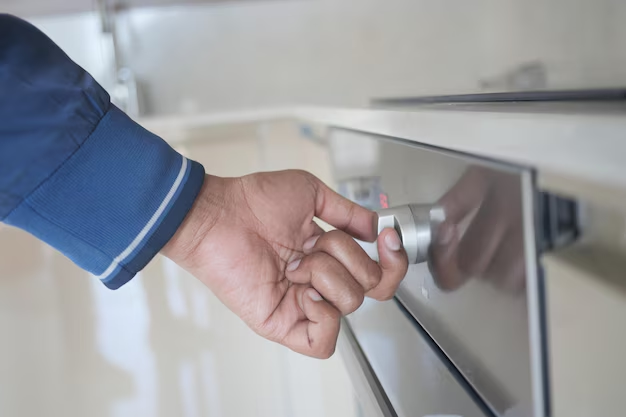Master the Art of Refrigerator Water Filter Installation: A Step-by-Step Guide
Are you tired of the unpleasant taste of tap water or worried about impurities in your drinking water? Installing a water filter on your refrigerator is an effective and convenient solution. With the right water filter setup, you can enjoy fresh, clean water straight from your fridge, enhancing the taste of your drinking water and providing peace of mind. Let's explore how to install a water filter on a refrigerator, along with detailed insights to help you understand the process better.
Why You Need a Refrigerator Water Filter
Refrigerator water filters are essential for several reasons. They help remove contaminants, including chlorine, lead, and other impurities, improving the taste and quality of your water. Moreover, they support the longevity of your refrigerator's water system by preventing clogs and build-ups. Ensuring your water filter is properly installed and maintained means you're opting for a healthier lifestyle and investing in your family's well-being.
Choosing the Right Water Filter for Your Refrigerator
Understanding Compatibility
Before purchasing a water filter, ensure it is compatible with your refrigerator model. Different brands and models require specific filter types, so it's crucial to check your refrigerator's manual or the manufacturer's website for guidance on the right filter.
Types of Water Filters
Refrigerator water filters come in various types, including twist-on, push-in, and inline filters:
- Twist-on Filters: These are typically located in the base grille or within the fridge's interior, requiring a simple twist to install or remove.
- Push-in Filters: Usually found inside the fridge compartment, they are straightforward to replace by pushing them in and out of the filter housing.
- Inline Filters: These are installed behind the refrigerator, designed for water lines without built-in filters.
Features to Consider
When choosing a water filter, consider factors like filter lifespan, ease of installation, and the ability to remove specific contaminants. Look for filters certified by NSF/ANSI standards to ensure quality and safety.
Step-by-Step Guide to Installing a Water Filter
Now that you've chosen the ideal filter, it's time to install it. Follow these steps to ensure a seamless installation:
1. Gather Your Tools and Supplies
Before starting, gather essential tools such as a towel or small bucket (for potential water spills), the new water filter, and your refrigerator's user manual, if needed.
2. Turn Off the Water Supply
Locate and turn off the water supply to the refrigerator. This step prevents leaks and makes the filter installation process smoother.
3. Remove the Old Filter
For Twist-on Filters:
- Locate the Filter: Identify the filter housing, usually in the base grille or the fridge interior.
- Remove the Filter: Twist the old filter counterclockwise and gently pull it out.
For Push-in Filters:
- Identify the Filter Compartment: Look for the filter housing inside the fridge.
- Eject the Filter: Press the eject button or remove the filter cover, then pull the filter straight out.
For Inline Filters:
- Locate the Inline Filter: Check behind the refrigerator for the inline filter in the water line.
- Disconnect the Lines: Use pliers or twist the connectors to detach the filter from the line.
4. Install the New Filter
For Twist-on and Push-in Filters:
- Align and Insert: Line up the new filter with the housing, inserting it by twisting clockwise (twist filters) or pushing until it clicks (push filters).
- Check the Fit: Ensure the filter is securely in place without any gaps.
For Inline Filters:
- Attach the Lines: Connect the water line to the new inline filter by securing the connectors tightly.
- Ensure Alignment: Check that the line matches the water flow direction indicated on the filter.
5. Turn the Water Supply Back On
Once the new filter is installed, turn the water supply back on.
6. Flush the Filter
Run water through the new filter for about 5 minutes. This step eliminates any air pockets and initial impurities, ensuring your water tastes fresh.
7. Inspect for Leaks
Monitor for leaks in the filter housing and connections. Tighten any loose connections if necessary to avoid water spills.
Practical Tips for Maintenance
Maintaining your refrigerator water filter optimizes its performance and prolongs the appliance's lifespan. Here are some tips for effective filter maintenance:
- Regular Replacement: Change the filter every 6 months, or as recommended by the manufacturer, to ensure consistent water quality.
- Check Water Pressure: Low water pressure can indicate a clogged filter, requiring a replacement.
- Monitor Taste and Odor: If water quality deteriorates, it might be time for a new filter.
- Keep Records: Note the date of each filter replacement to stay on schedule.
Troubleshooting Common Installation Issues
1. Filter Won’t Fit: Verify you have the correct filter model. Contact the manufacturer if the issue persists.
2. Leaking Filter: Confirm all connections are secure. Reinstall the filter if needed.
3. Water Dispenser Issues: Ensure the filter is installed correctly and the water supply is turned on.
Summary: Key Takeaways for Swift Filter Installation
Here's a quick summary with essential tips for refrigerator water filter installation:
- 🚰 Choose the Right Filter: Verify compatibility with your fridge model.
- 🔧 Gather Tools: Prepare necessary tools before installation.
- 🚿 Properly Turn Off/On Water Supply: Prevent leaks by controlling the water flow.
- 🔄 Correct Replacement Technique: Follow specific instructions for filter types.
- 👀 Inspect for Leaks: Check connections for peace of mind.
- 🗓️ Regular Maintenance: Schedule timely replacements for optimal performance.
Installing a refrigerator water filter is a simple, cost-effective way to improve your water quality at home. By following this guide, not only do you empower yourself with the knowledge to maintain your refrigerator efficiently, but you also foster healthier hydration habits for you and your family. Remember, regular checks and replacements keep your filter—and your water—at its best. Happy hydrating!
